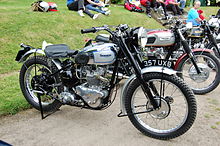
The Triumph sprung hub is a motorcycle suspension unit contained within a rear wheel hub. It was designed by Triumph engineer Edward Turner to give Triumph's existing rigid frames the option of rear suspension. It was one of the first motorcycle components to have a safety warning cast into its housing.
Design and development
Edward Turner designed Triumph's sprung hub in 1938. The design was inspired by Dowty hubs with suspension within them, as used in the fixed landing gear of Gloster Gladiator fighter aircraft. Turner's design used a plunger-type suspension made small enough to fit inside the wheel hub. With one spring above the rear axle and two below, the sprung hub provided about two inches of vertical travel and weighed 17 pounds (7.7 kg) more than a conventional hub. It was designed to allow rear suspension to be offered optionally without altering Triumph's existing frames. The sprung hub did not provide a drive gear for the speedometer, so the design of the transmission was revised to provide the required drive gear.
Frank Baker, the head of the Experimental Department at Triumph, tried to convince Turner that the handling of Triumph motorcycles at the time the sprung hub was available was potentially dangerous at speed, to the point of having himself filmed while riding one of them on a test track at speed. Turner ignored Baker's efforts and continued with the sprung hub.
Reception
Turner had intended to introduce the sprung hub with Triumph's 1940 motorcycles, but the outbreak of the Second World War prevented this; the sprung hub was ultimately introduced in 1946. The Mk. 2 version replaced the original in 1951. While the original version was provided with a grease nipple, the Mk. II version had no provision for greasing, with the factory grease packing expected to last for 20,000 miles (32,000 km). The sprung hub was the only rear suspension offered with Triumph's parallel-twin motorcycles until 1955.
Legacy
The sprung hub is remembered as one of the first motorcycle products to have a safety warning cast into its housing. It is also remembered for inadequacy, being described as "a pain in the rear end" and "one of the weirdest and worst rear suspension systems of all time."
References
- Citations
- ^ Brooke, Triumph: A Century of Passion and Power, pp.51 – 52
- Cameron and Buell, Top Dead Center 2: Racing and Wrenching with Cycle World's Kevin Cameron, p. 93
- ^ Brooke, Triumph: A Century of Passion and Power, p.56
- ^ Triumph Workshop Instruction Manual for Models 1945 - 1955, "Spring Wheel—Mk. 2", pp. 131 – 132
- ^ Remus, Triumph Motorcycles: Twins & Triples, p.20
- Triumph Workshop Instruction Manual for Models 1945 - 1955, "Supplemental Instructions", p. 184
- ^ Zimmerman and Hackett, How to Restore Your Motorcycle, p. 109
- Bibliography
- Brooke, Lindsay (November 2002). "Chapter Three Triumph in the 1950s: The Thunderbird". Triumph: A Century of Passion and Power. MotorBooks International. ISBN 978-0-76-030456-3.
- Cameron, Kevin; Buell, Erik (2009-11-12). "March 1983 Chassis and Suspension, Part 1". Top Dead Center 2: Racing and Wrenching with Cycle World's Kevin Cameron. MBI Publishing. p. 93. ISBN 978-0-76-033608-3.
Even Triumph grudgingly acknowledged the validity of the trend by offering (as an option only, mind you) the "sprung hub," a form of plunger rear suspension in which all the mechanism was stuffed inside the rear hub.
- Remus, Timothy (1997-10-10). "Chapter 2 Evolution of a Great Design – The Fast, Furious Fifties". Triumph Motorcycles: Twins & Triples. Motorbooks International. p. 20. ISBN 978-0-76-030312-2.
In answer to riders' requests for rear suspension Triumph offered a 'sprung hub.' This consisted of a large rear-wheel hub assembly that allowed nearly two inches of vertical travel as the machine passed over bumps.
- Triumph Workshop Instruction Manual for Models 1945 - 1955 (pdf). Triumph Engineering. April 1964. Publication Part No. 99-0836. Retrieved 2012-06-16.
- Zimmerman, Mark; Hackett, Jeff (7 May 2010). "Chapter 11: Frames". How to Restore Your Motorcycle. Photographs by Jeff Hackett (Second edition, illustrated ed.). Motorbooks International. p. 109. ISBN 978-0-76-033772-1.
One of the weirdest and worst rear suspension systems of all time is the infamous Triumph Sprung Hub—one of the first devices to carry a cast-in warning. These should only be taken apart if you're experienced, you're brave, and you have the right tools.